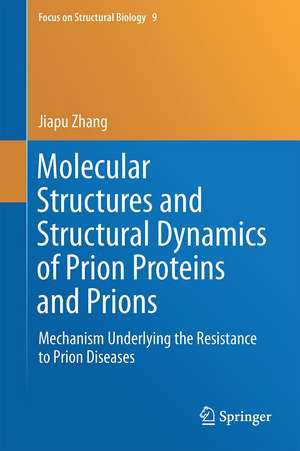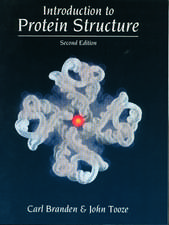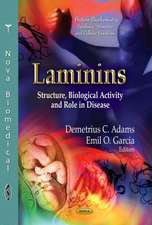Molecular Structures and Structural Dynamics of Prion Proteins and Prions: Mechanism Underlying the Resistance to Prion Diseases: Focus on Structural Biology, cartea 9
Autor Jiapu Zhangen Limba Engleză Hardback – 25 sep 2015
PrPC is predominant in α-helices but PrPSc are rich in β-sheets in the form as amyloid fibrils; so very amenable to be studied by MD techniques. Through MD, studies on the proteinstructures and the structural conversion are very important for revealing secrets of prion diseases and for structure-based drug design or discovery. Rabbits, dogs, horses and buffaloes are reported to be the few low susceptibility species to prion diseases; this book's MD studies on these species are clearly helpful to understand the mechanism underlying the resistance to prion diseases. PrP(1-120) usually has no clear molecular structures; this book also studies this unstructured region through MD and especially MM techniques from the global optimization point of view.
This book is ideal for practitioners in computing of biophysics, biochemistry, biomedicine, bioinformatics, cheminformatics, materials science and engineering, applied mathematics and theoretical physics, information technology, operations research, biostatistics, etc. As an accessible introduction to these fields, this book is also ideal as a teaching material for students.
| Toate formatele și edițiile | Preț | Express |
|---|---|---|
| Paperback (1) | 791.14 lei 38-44 zile | |
| SPRINGER NETHERLANDS – 29 oct 2016 | 791.14 lei 38-44 zile | |
| Hardback (1) | 960.13 lei 22-36 zile | |
| SPRINGER NETHERLANDS – 25 sep 2015 | 960.13 lei 22-36 zile |
Preț: 960.13 lei
Preț vechi: 1170.89 lei
-18% Nou
Puncte Express: 1440
Preț estimativ în valută:
183.75€ • 191.12$ • 151.69£
183.75€ • 191.12$ • 151.69£
Carte disponibilă
Livrare economică 24 martie-07 aprilie
Preluare comenzi: 021 569.72.76
Specificații
ISBN-13: 9789401773171
ISBN-10: 9401773173
Pagini: 355
Ilustrații: XIX, 355 p. 179 illus., 176 illus. in color.
Dimensiuni: 155 x 235 x 27 mm
Greutate: 0.87 kg
Ediția:1st ed. 2015
Editura: SPRINGER NETHERLANDS
Colecția Springer
Seria Focus on Structural Biology
Locul publicării:Dordrecht, Netherlands
ISBN-10: 9401773173
Pagini: 355
Ilustrații: XIX, 355 p. 179 illus., 176 illus. in color.
Dimensiuni: 155 x 235 x 27 mm
Greutate: 0.87 kg
Ediția:1st ed. 2015
Editura: SPRINGER NETHERLANDS
Colecția Springer
Seria Focus on Structural Biology
Locul publicării:Dordrecht, Netherlands
Public țintă
ResearchCuprins
Basic Knowledge.- The Homology Structure and Dynamics.- The NMR Structure and Dynamics of the Wild-type and Mutants.- Compared with the NMR Structure and Dynamics of Humans and Mice.- Compared with the NMR Structure and Dynamics of Dogs and Horses.- Compared with a Homology Structure and Dynamics of Buffaloes.- Compared with NMR Structure and Dynamics of Elks.- Compared with the X-ray Structure and Dynamics of Rabbits.- Surface Electrostatic Charge Distributions.- The Hydrophobic Region PrP(109–136).- The Hybrid Method of Steepest Descent - Conjugate Gradient with Simulated Annealing.- Hybrid Method of Discrete Gradient with Simulated Annealing or Genetic Algorithm.- A Novel Canonical Dual Global Optimization Computational Approach.- The Hybrid Method of Evolutionary Computations with Simulated Annealing.- Simulated Annealing Refined Replica Exchange Global Search Algorithm.- LBFGS Quasi-Newtonian Methods for MM Prion AGAAAAGA Amyloid Fibrils.- Particle Swarm Global Optimization Search Algorithm.- A Summary of the Research Works on AGAAAAGA.
Recenzii
“There is a wealth of information and insight in the results presented and in the methods employed. The research is important. The methods used are innovative. Studying this book is worth the effort.” (Anthony J. Duben, Computing Reviews, computingreviews.com, September, 2016)
Textul de pe ultima copertă
This monograph is the first easy-to-read-and-understand book on prion proteins' molecular dynamics (MD) simulations and on prions' molecular modelling (MM) constructions. It enables researchers to see what is crucial to the conformational change from normal cellular prion protein (PrPC) to diseased infectious prions (PrPSc), using MD and MM techniques. As we all know, prion diseases, caused by the body's own proteins, are invariably fatal and highly infectious neurodegenerative diseases effecting humans and almost all animals for a major public health concern. Prion contains no nucleic acids and it is a misshapen or conformation-changed protein that acts like an infectious agent; thus prion diseases are called “protein structural conformational” diseases.
PrPC is predominant in α-helices but PrPSc are rich in β-sheets in the form as amyloid fibrils; so very amenable to be studied by MD techniques. Through MD, studies on the proteinstructures and the structural conversion are very important for revealing secrets of prion diseases and for structure-based drug design or discovery. Rabbits, dogs, horses and buffaloes are reported to be the few low susceptibility species to prion diseases; this book's MD studies on these species are clearly helpful to understand the mechanism underlying the resistance to prion diseases. PrP(1-120) usually has no clear molecular structures; this book also studies this unstructured region through MD and especially MM techniques from the global optimization point of view.
This book is ideal for practitioners in computing of biophysics, biochemistry, biomedicine, bioinformatics, cheminformatics, materials science and engineering, applied mathematics and theoretical physics, information technology, operations research, biostatistics, etc. As an accessible introduction to these fields, this book is also ideal as a teaching material for students.
PrPC is predominant in α-helices but PrPSc are rich in β-sheets in the form as amyloid fibrils; so very amenable to be studied by MD techniques. Through MD, studies on the proteinstructures and the structural conversion are very important for revealing secrets of prion diseases and for structure-based drug design or discovery. Rabbits, dogs, horses and buffaloes are reported to be the few low susceptibility species to prion diseases; this book's MD studies on these species are clearly helpful to understand the mechanism underlying the resistance to prion diseases. PrP(1-120) usually has no clear molecular structures; this book also studies this unstructured region through MD and especially MM techniques from the global optimization point of view.
This book is ideal for practitioners in computing of biophysics, biochemistry, biomedicine, bioinformatics, cheminformatics, materials science and engineering, applied mathematics and theoretical physics, information technology, operations research, biostatistics, etc. As an accessible introduction to these fields, this book is also ideal as a teaching material for students.
Caracteristici
Systemically studies the structures of prion proteins, especially the PrP models of resistant species to prion diseases (dog, rabbit, horse and buffalo) Introduces local and global search computational optimization into the studies of prion protein structures and neurodegenerative amyloid fibrils Unites and analyzes structures of prion proteins standing on the point of view and systemically carries out the molecular dynamics simulations of the prion protein structures






















